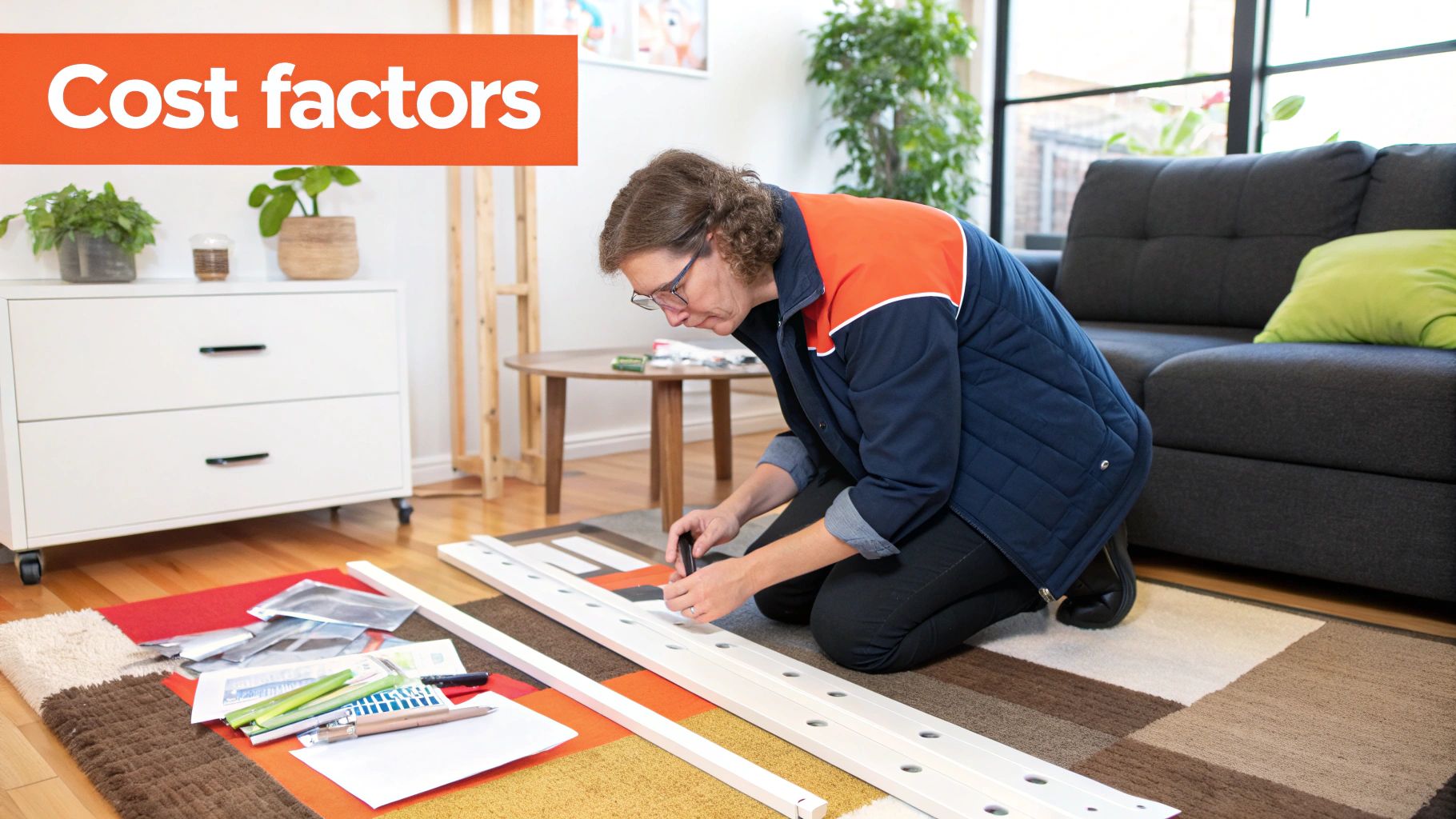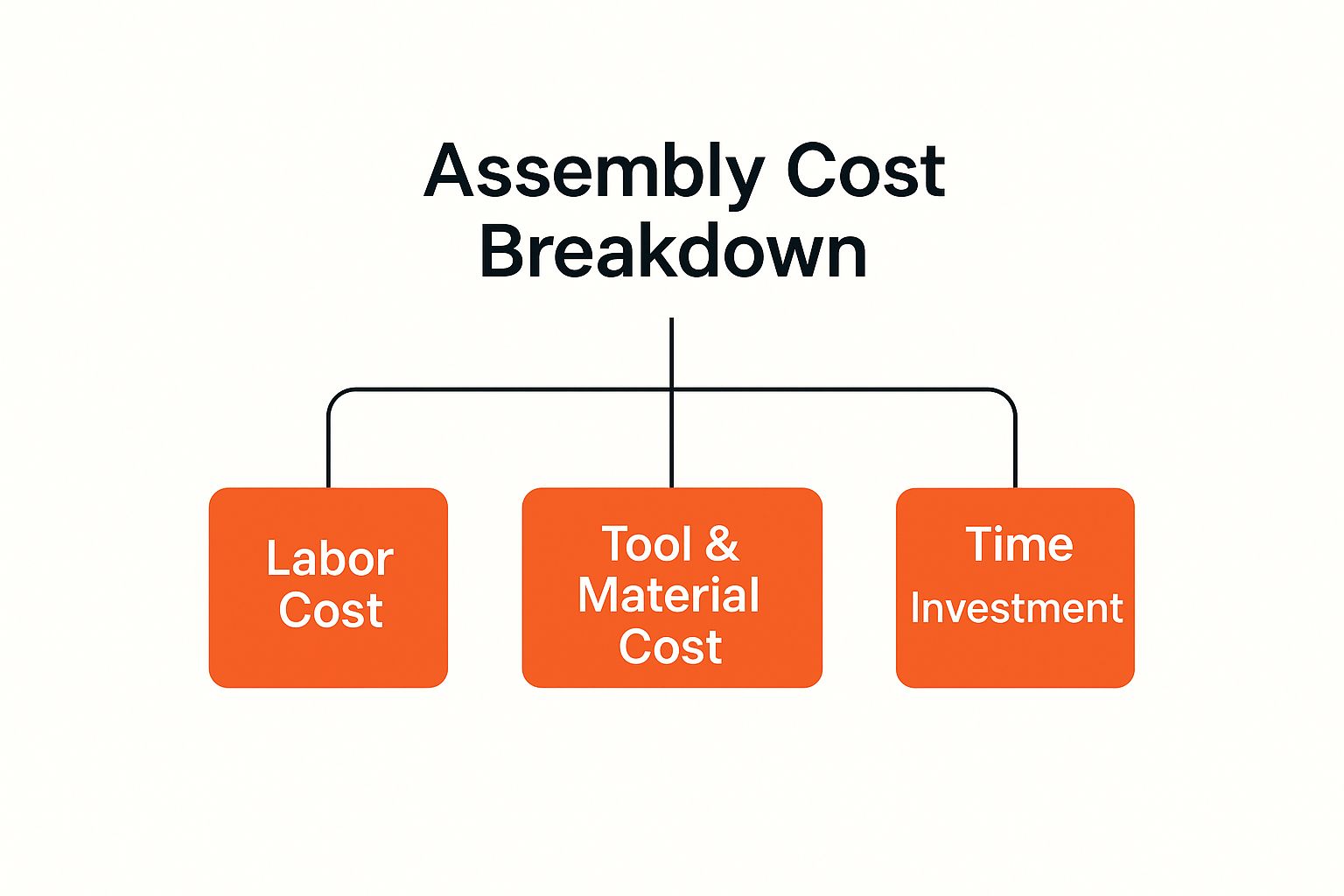-
CALL US:
- (866) 952-3456
So, you've got a brand-new flat-pack box sitting in your living room. Before you even think about deciphering those hieroglyphic instructions, the big question looms: "How much is it going to cost to get someone else to build this thing?"
Let's get straight to it. The average cost to assemble furniture lands at about $150 per piece. But that's just an average. A simple task might only set you back $40, while a beast of a project like a large wardrobe or a backyard swing set could climb to over $500. It all comes down to what you have, as pros usually charge by the hour or by the item.

Getting a clear handle on the potential costs is the first step in deciding whether to hire a professional or brave the assembly yourself. Think of this section as your financial snapshot—a quick, honest summary of what you can expect to pay.
We'll start with the big picture before digging into the nitty-gritty details for different types of furniture. This will give you a solid baseline so you can budget with confidence.
Based on recent projects in 2025, that $150 per piece figure is a reliable starting point. However, the range is huge. You could pay as little as $40 for something straightforward like a nightstand, or you might see quotes climbing toward $1,000 for a massive, multi-component entertainment center.
To put that in perspective, a standard bed frame might take about two hours and cost around $180. On the other hand, a big outdoor swing set is a much larger job, often requiring six to ten hours of work and pushing the final price into the $180 to $500 range.
Most professional handypeople charge an hourly rate, which averages around $90 per hour, but you'll see it swing anywhere from $40 to $140. For a deeper dive into these numbers, you can find a lot more information in HomeAdvisor's detailed cost guide.
Key Takeaway: If you have multiple items, always ask about a bulk discount. Assemblers are often willing to knock 10% to 30% off the total bill for larger jobs, since it's more efficient for them to handle everything in one visit.
To give you an even clearer idea of what to expect, we've put together a table with typical costs for common furniture items. Use these figures to get a rough estimate for your own project.
This table shows the typical cost range and estimated assembly time for common household furniture items, helping you budget for your specific needs.
| Furniture Item | Estimated Assembly Time | Average Cost Range |
|---|---|---|
| Nightstand or End Table | 30 – 60 minutes | $40 – $80 |
| Coffee Table | 1 – 1.5 hours | $60 – $120 |
| Standard Desk | 1.5 – 2.5 hours | $90 – $200 |
| Dresser (3-6 Drawers) | 2 – 4 hours | $120 – $300 |
| Bed Frame (with headboard) | 1.5 – 3 hours | $100 – $250 |
| Bookcase (5-shelf) | 1 – 2 hours | $75 – $150 |
| Wardrobe or Armoire | 3 – 6 hours | $200 – $500+ |
| Dining Table & 4 Chairs | 2 – 3.5 hours | $150 – $280 |
Keep in mind these are just estimates. The actual price can shift based on the complexity of your specific item, where you live, and the assembler's experience.
Ever wondered why one dresser costs $80 to assemble while a nearly identical one gets a quote for $250? The secret isn't just about the size of the box; it's about what's inside it. To get a real grip on what you'll pay, you need to understand the details that drive the final price.
Think of it like building with LEGOs. Snapping together a simple car is a walk in the park compared to tackling the 7,000-piece Millennium Falcon. Both are just plastic bricks, but the sheer number of pieces, the complexity, and the time required create a huge difference in effort. Furniture is exactly the same. The more parts, drawers, doors, and tiny pieces of hardware, the longer the job takes—and that directly bumps up the labor cost.
The physical size and weight of the item are also big-ticket factors. A heavy, oversized wardrobe isn't a one-person job. It takes more strength, careful maneuvering, and often a second pair of hands just to safely lift and position the panels. That extra effort and risk will always be reflected in the price.
Let's be honest: not all furniture is created equal. The brand name itself can be a clue about how tricky the assembly will be. An IKEA piece, for instance, is specifically designed for the average person to build at home using picture-based instructions. On the other hand, high-end or specialty items like those found in a sofa shop can feature more complex joinery, delicate finishes, and vague instructions that demand a much higher level of skill and care.
The materials matter, too. Working with solid wood is a completely different ballgame than assembling particleboard. One wrong move with particleboard can strip a screw hole or crack a panel, forcing an experienced pro to work much more deliberately to avoid damage.
This diagram really breaks down where the money goes.

As you can see, the time it takes and the direct labor involved are, by far, the biggest pieces of the pricing puzzle.
Beyond the furniture itself, a few other things can move the price needle. People often forget about these, but they’re just as important when you're setting a budget.
A critical mistake is assuming every quote should be in the same ballpark. That lowball offer might be from someone who will take twice as long and do a shoddy job. A higher quote often reflects the efficiency, insurance, and reliability of a true professional.
Ultimately, the cost to assemble furniture is a mix of the item's complexity, the pro's skill level, and your specific situation. For a deeper dive, check out our complete guide on https://assemblysmart.com/furniture-assembly-cost/ to see how all these pieces fit together.

Once you’ve decided to save yourself the headache of a DIY project, the next question is: where do you find the right person for the job? There are a few different avenues you can take, and each has its own pros and cons. The best choice for you will probably depend on how you balance cost, convenience, and peace of mind.
It’s a bit like getting dinner. You can use a delivery app for speed and variety, order directly from your favorite restaurant for consistency, or find a local chef who comes highly recommended. All three get you fed, but the experience, price, and quality will be different.
Platforms like TaskRabbit and Handy have completely changed the game. They’re essentially marketplaces for independent contractors. You can scroll through profiles, check out hourly rates, and book someone, sometimes even for the very same day. This approach gives you a ton of flexibility and often leads to competitive prices.
The trade-off? The quality can be a real mixed bag. While you'll find plenty of highly-rated pros who know their stuff, you might also find someone with less experience. It’s absolutely essential to read reviews and see if the platform provides any insurance or protection if something goes sideways with your furniture or home.
Big furniture stores, with IKEA being the most famous example, often have their own assembly teams. When you buy that new bookshelf, you can just add professional assembly right at checkout. The big win here is accountability. The service is tied directly to the store, meaning the assemblers are specialists in that exact product line.
With this option, you’re usually paying a fixed price per item, not an hourly rate, so you know the final cost upfront. It might be a little more expensive than hiring a freelancer, but the specialized expertise and confidence it brings can be worth every penny, especially for bigger, more complicated pieces.
The decision often comes down to what you value more: a lower price or guaranteed reliability. Gig platforms might save you money but require you to do your homework. Retailer services cost a bit more but take the guesswork out of the equation.
Never underestimate a good, old-fashioned local handyman. These are the pros who build their businesses on word-of-mouth and a solid reputation right in your community. Going local often means you get a more personal touch from someone who has worked with all sorts of brands and furniture types.
Where do you find them? Try asking for recommendations in neighborhood social media groups, check with your local hardware store, or just ask a neighbor. When you hire a professional furniture assembly service, you're paying for experience and efficiency. A trusted local expert delivers that in spades, usually carrying their own insurance and standing behind their work—a fantastic blend of value and dependability.

When you think of furniture assembly, you might picture someone struggling with a new bed frame in their bedroom. But for businesses, offices, and large residential complexes, outfitting a space is a whole different beast. The pricing for commercial-scale assembly isn't just a bigger version of a home project—it’s an entirely different game, moving away from simple per-piece fees toward comprehensive project estimates.
Let's put it this way: assembling one dresser is like baking a cake at home. Outfitting a 50-person office, on the other hand, is like catering a wedding. The sheer scale changes everything. Suddenly, you're dealing with project management, delivery coordination, and tight deadlines, all of which require a much more sophisticated pricing structure than a simple hourly rate.
For any large-scale job, you'll rarely see an assembler charge by the hour or by the item. What you'll get instead is a project quote that bundles labor, management, and other services into a single, all-inclusive price. This approach gives the business cost certainty and allows the assembly company to plan and manage its resources effectively.
Why the shift? It all comes down to the layers of complexity involved in a big project.
The real value in commercial assembly isn't just building the furniture; it's the end-to-end service. This includes unboxing, assembly, placement according to floor plans, and complete cleanup, allowing a business to become operational almost immediately.
In the world of commercial furniture, assembly is often bundled right into the total procurement contract. A company spending $50,000 on new office desks and chairs will likely negotiate assembly as part of the overall deal, rather than hiring a separate company for the job. This integrated approach is especially common in markets with high demand for full-service office outfitting.
In North America and Europe, it’s standard practice for large furniture suppliers to have extensive price lists where assembly services are already factored into the project cost, particularly for complex items like modular desking systems. This makes sense—the scope of these projects guarantees a significant labor cost, so it’s more efficient to manage it within the main contract. You can see how manufacturers present these large-scale packages by looking through their commercial furniture price lists. It’s a clear market trend: assembly is treated as a built-in component of the purchase, not a separate line-item you have to worry about later.
Getting a fair and accurate quote for furniture assembly isn't just about finding the lowest number. It’s about giving the professional the right information upfront so you can avoid that dreaded sticker shock when the job is done.
Think of it this way: if you ask a mechanic to "fix the weird noise in my car," you'll get a vague estimate. But if you say, "There's a rattling sound from the front right wheel when I go over 40 mph," they can give you a much more solid quote. The same principle applies here. A simple "I need a dresser assembled" leaves way too much to guesswork.
The goal is to paint a crystal-clear picture of the job so the assembler knows exactly what they’re getting into.
To make sure the cost to assemble furniture you're quoted is the price you actually pay, you need to be specific. The more details, the better. When an assembler has all the facts, they can give you a reliable flat-rate price or a very tight time estimate.
Here’s a quick checklist of what to send over with your quote request:
Being thorough doesn't just help the assembler—it protects you. It creates a clear record of the job, which makes it much easier to hold the company to their initial price. For more tips on getting your space ready, check out our guide on how to prepare for your furniture assembly project.
Unfortunately, some quotes are designed to be misleading. A lowball offer can quickly balloon with extra fees you never saw coming. Knowing what these common upcharges are helps you ask the right questions before you hire someone.
A truly professional service will be upfront about all potential costs. If a quote seems too good to be true, it’s probably because they plan to tack on fees later.
Make sure to ask specifically about these potential add-ons:
Deciding whether to build that new piece of furniture yourself or call in a pro can feel like a simple matter of money. But the real math behind the cost to assemble furniture is more complex than just comparing a handyman's fee to zero. It's really about what you value most: your time, your skill, and frankly, your sanity.
Before you roll up your sleeves and tear open that box, take a moment to consider the hidden costs of going it alone. That dresser that looks like a two-hour project on the box? It can quickly eat up an entire Saturday, especially when you hit a snag with confusing instructions or realize a crucial part is missing. What's that time worth to you? For many people, skipping hours of potential frustration is worth every penny of a professional's fee.
Think beyond the dollar signs and consider the other trade-offs. Tackling assembly yourself often means dealing with a few common headaches:
Deciding between DIY and professional help is a classic homeowner's dilemma. As you weigh your options, it's helpful to check out resources evaluating professional versus DIY costs, which can really put the true value of hiring an expert into perspective.
For products from brands known for their tricky instructions, getting professional help is less of a luxury and more of a smart investment. For instance, our deep dive into IKEA furniture assembly breaks down exactly why having a pro handle those specific items saves you a world of trouble and guarantees a sturdy, safe result.
Ultimately, hiring someone is absolutely worth it if it means avoiding stress, protecting your new purchase from accidental damage, and getting a perfectly assembled piece of furniture you can enjoy right away.
Alright, we've covered a lot of ground on what it costs to have furniture put together. But I know from experience that once you've digested all the numbers, a few practical "what-if" questions usually pop up. Let's tackle those last few lingering thoughts so you can feel completely confident when you hire someone.
This is probably the most common question I get. The short answer is that while tips are never expected, they are always, always appreciated. Think of it this way: these folks are saving you hours of frustration (and maybe a few arguments). If your assembler did an amazing job—maybe they were super quick, handled a really complex piece with ease, or were just a pleasure to have in your home—a tip is a fantastic way to say thank you.
So, what's a good amount? A good rule of thumb is 10-20% of the total service cost. If it was a smaller job, a flat $10 to $20 is a great gesture that acknowledges their skill and hard work.
It's a totally valid fear. You've just spent good money on a new piece, and the last thing you want is a scratch or a broken part. This is precisely why hiring an insured professional is so critical. Before any work starts, you should always confirm that your assembler or their company carries liability insurance. It’s the hallmark of a true professional.
If an accident does happen, a pro service will have a straightforward process for making it right. This could mean repairing the damage, arranging a replacement, or providing a refund. This peace of mind is something you simply don't get when you hire an uninsured handyman for cash.
You sure can! In fact, you absolutely should ask. Most assembly services are more than happy to give you a better deal if you bundle several pieces into one appointment. It’s far more efficient for them to build a whole bedroom set in one visit than to make separate trips for the bed, then the dresser, then the nightstands.
By scheduling everything at once, you can often save 10-30% on the total bill. When you're getting your quote, just make sure to mention you have multiple items and ask if they offer a bulk-rate discount.
Ready to skip the instruction manual and get your furniture built right? The team at Assembly Smart is here to help. We offer fast, reliable, and professional assembly services with upfront, transparent pricing. Get your free estimate today and enjoy your new furniture without the headache. Visit us at https://assemblysmart.com to book your appointment.